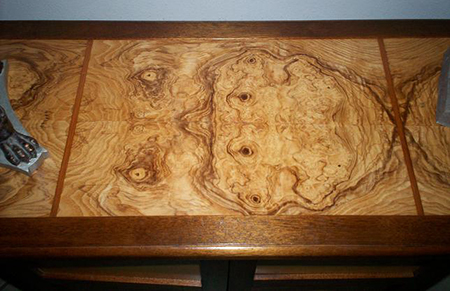
A dedicated husband is making raised panel cabinet doors and his spouse wants him to veneer them (4-part checkerboard pattern). Can he do this and, if so, how?
Ellis Walentine: This is another one of those questions that could take a book to cover all the possibilities, tricks and nuances of the process; but the basic advice is to cut the squares very accurately, tape them together into a sheet, and glue them onto the substrate using waxed cauls, beams and clamps. You’ll also have to glue a “backer” veneer on the opposite face of the panel to balance the construction, so the panel won’t be tempted to warp or cup as the humidity changes.
Here are a couple of tricks that might help: First, cut the veneer to size using a rigid straightedge and a veneer saw (one of those little double edged saws with the curved blades); then use a shooting board and a very sharp block plane to prepare the edges of the veneer perfectly before taping. You could clamp your veneers together between two pieces of plywood with just a tiny bit sticking out, then use the plywood edges as your shooting board. Next, use masking tape to hold the pieces together. Paper veneer tape works fine if it’s fresh, but masking tape stretches and acts as a mini clamp across the joint line. Also, if the panel is too wide to get clamping pressure directly and uniformly over the surface of the glue-up, use fairly heavy hardwood beams to span the waxed plywood or particleboard cauls that you stack over and under the components. Plane or bandsaw a slight crown or belly on these beams so that when you tighten the clamps at the ends it magnifies the pressure in the center.
Ian Kirby: The notion is counterintuitive, a sort of mixed metaphor. If you use solid wood for the panel, then half of the veneer will be laid at right angles to the grain of the panel ?they will split or open joints as the panel shrinks and expands. The top and bottom beveled faces of the border are usually oddly marked because the grain is cut at an angle. You can expect dueling grains. Both conditions could be changed if you used MDF as the substrate. My solution would be to veneer an MDF panel and leave about a 1/4″ shadow line all around between the panel and frame.





